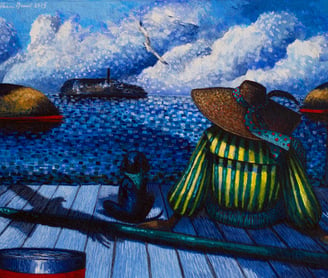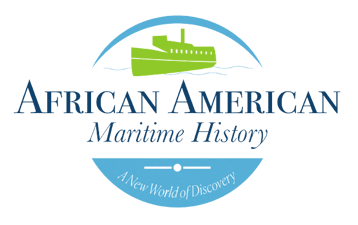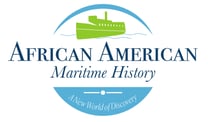African American Maritime History Series #3: Roles and Responsibilities of Enslaved Water Workers


According to the 1860 census, nine of America's 19 largest slaveholders were South Carolinians. These nine slaveholders amassed huge fortunes based on the primary cash crop of Rice. During the 1700’s enslaved people, who originated from the West Coast of Africa, labored under deadly conditions to grow a crop that was as profitable as gold. Over 40,000 acres of land was cleared, and 780 miles of canals were dug by the beginning of the 1800s. Disease, heat-stroke, and injuries killed many who worked the rice fields, but the rice was so valuable that the demand for enslaved people grew. The fields had to be carved out of tidal swamp lands where huge cypress and gum trees grew. The swamps were full of alligators, snakes, and disease carrying mosquitoes and these enslaved Africans, later called Gullah Geechee, overcame it all to build the South Carolina rice plantations around Charleston, Georgetown, Beaufort and throughout the Lowcountry.
Port cities were established all along the colonial Atlantic coast. Ship building industries came to life, particularly in the New England region – by the 1770’s, America was making 1/3 of all Britain’s trading vessels. During the Colonial Era, distinct region di"erences and trades begin to emerge; while the South developed an agricultural community, the North leaned toward various industrial pursuits – particularly ship building (and all the trades involved in that process) and other maritime industries.
Rice has traditionally thrived in warm, wet climates. The Lowcountry, replete with the conditions necessary for rice as a crop to flourish, is a geographic and cultural region from North Carolina to Northern Florida down the Atlantic coast, including the Sea Islands. The region includes significant salt marshes and other coastal waterways. The South Atlantic coastal Lowcountry is not only bordered by the Atlantic Ocean, but the area also consists of internal waterways such as lakes, rivers, tidewaters. canals, non-tidal rivers, tidal rivers, large, deep lakes and lochs, and estuaries. Because of the vast waterway infrastructure, the predominant environment can be described as maritime. Maritime is a term used to denote anything that is connected to the sea and other waterways, especially when it comes to seafaring trade and industry. During the colonial era in the Lowcountry, enslaved Africans were responsible for most of the maritime labor throughout the region.


The antebellum Lowcountry was a watery empire where enslaved boatmen explored and exhibited maritime skills acquired from local experiences or imported from Africa. Their labor in this maritime setting created a unique society and culture. Boatmen rowed and maneuvered plantation boats called periaguas and schooners. Enslaved fishermen, oyster catchers, shrimpers and crab catchers provided food for plantation kitchens, and skilled craftsmen worked as laborers in commercial, urban shipyards and ports, building sailing ships for the Atlantic coastal and international trade. Watercraft was of utmost importance for commercial transportation and travel as the waterways were the primary transportation system of the colonial world. The skilled enslaved people who built and operated these vessels were a distinctive class in the Southern coastal port cities throughout the Lowcountry. Their counterparts in the Northern Atlantic coastal regions were typically freedmen and they specialized in maritime trades which were more deep sea focused such as whaling. According to W. Je"ery Bolster, “Mariners over generations—slave and free, white and black—created an Atlantic maritime culture that reflected their work and status (Bolster, 1998).
Colonial America was not yet established as the United States of America. Therefore, the Thirteen Colonies comprised the administrative and societal framework. The Atlantic Ocean bordering the colonies served as the main transportation superhighway enabling trade, communication, and travel between the colonies. It also provided a means for the Thirteen Colonies to strengthen economically by exporting and importing essential goods on the triangular trade routes. The success of American maritime industries (including ship building, fishing, and whaling) and import/exports prompted controlling laws from England.
Enslaved seamen in the Lowcountry handled most of the maritime laborer positions. Enslaved patroons (boat captains) and their crews provided an invaluable service to planters, who had to bring their staple products—rice, indigo, deerskins, and cotton—to market and communicate amongst themselves, but they were also purveyors of information for networks of rebellious communications, illicit trade as defined for enslaved persons, and escapes by the enslaved.


Names and descriptions of some of the jobs performed by enslaved laborers in the Lowcountry maritime economy.
Barrelman Barrelman - a person who would be stationed in the barrel of the foremast or crow's nest of an oceangoing vessel as a navigational aid. In early ships the crow's nest was simply a barrel or a basket lashed to the tallest mast. Later it became a specially designed platform with protective railing.
Boatman Boatman- a man who takes people or goods somewhere in a small boat.
Boatsteerer Boatsteerer- a position on a nineteenth-century whaleship. One of the most responsible members of the crew, his duty was to pull the forward oar of a whaleboat until reaching striking distance of a whale. He then would harpoon the whale with an iron while the boat-handler (mate) guided the boat.
Boatswain, bo's'n, bos'n, or bosun Boatswain, bo's'n, bos'n, or bosun- a deck boss, or a qualified member of the deck department, is the most senior rate of the deck department and is responsible for the components of a ship's hull. The boatswain supervises the other members of the ship's deck department, and typically is not a watchstander, except on vessels with small crews. Additional duties vary depending upon ship, crew, and circumstances.
Cabin boy Cabin boy- is a boy (in the sense of low-ranking young male employee, not always a minor in the juridical sense) who waits on the o"icers and passengers of a ship, especially running errands for the captain. The modern merchant navy successor to the cabin boy is the steward's assistant.
Canoe man Canoe man-one who travels by canoe.
Caulker Caulker- responsible for making the watercraft watertight or airtight by filling or sealing.
Cooper-a person trained to make wooden casks, barrels, vats, buckets, tubs, troughs and other similar containers from timber staves that were usually heated or steamed to make them pliable.
Coxswain Coxswain- the person in charge of a boat, particularly its navigation and steering.
Crewman Crewman- a man who is a member of the crew of a ship.
Docker- Docker- someone whose job is to take goods on and o" ships at a dock.
Dockmaster Dockmaster- a person in charge of a dock used for freight, logistics, and repair or maintenance of ships (a shipyard or drydock). This title is distinct from harbormaster, which is sometimes a higher rank than dockmaster.
Drayman Drayman- A drayman was historically the driver of a dray, a low, flat-bed wagon without sides, pulled generally by horses or mules that were used to transport all kinds of goods.
Engagé- a French-Canadian man employed to canoe in the fur trade, usually as an indentured servant. The term was also applied to the men who sta"ed the pirogues on the Lewis and Clark Expedition.
Engineer Engineer- someone who controls the engines on a ship or aircraft.
Factor- cotton planters relied on cotton factors (also known as commission merchants or cotton brokers) to sell their crops for them.
Ferryman-operator of a ferry.
Fisherman-a catcher of fish.
Hand- someone who works on a ship.
Harbourmaster- an o"icial responsible for enforcing the regulations of a particular harbour or port, in order to ensure the safety of navigation, the security of the harbour and the correct operation of the port facilities.
Helmsman- a person who steers a ship, sailboat, submarine, other type of maritime vessel, or spacecraft.
Lighterman- a worker who operates a lighter, a type of flat-bottomed barge, which may be powered or unpowered. In the latter case, today it is usually moved by a powered tug.
Longshoreman-a docker.
Mariner-a sailor. Maritime pilot Maritime pilot- a mariner who maneuvers ships through dangerous or congested waters, such as harbors or river mouths.
Merchant- a buyer and seller of commodities for profit.
Navigator- a person who is skilled in or performs navigation, especially on a ship.
Netmaker-one who makes fishing nets.
Old salt- an old sailor with a lot of experience.
Oystercatcher-a person who catches oysters.
Pilot- a water transportation worker who operates and maintains vessels that take cargo and people over water.
Planter-the planter class, known alternatively in the United States as the Southern aristocracy, was a socio-economic caste of Pan-American society that dominated 17th and 18th century agricultural markets through the slavery of African Americans.
Powder boy or Powder monkey- manned naval artillery guns as a member of a warship's crew, primarily during the Age of Sail. His chief role was to ferry gunpowder from the powder magazine in the ship's hold to the artillery pieces, either in bulk or as cartridges, to minimize the risk of fires and explosions. The function was usually fulfilled by boy seamen of 12 to 14 years of age. Powder monkeys were usually boys or young teens, selected for the job for their speed and height: they were short and could move more easily in the limited space between decks and would also be hidden behind the ship's gunwale, keeping them from being shot by enemy ships' sharpshooters.
Ropemaker- a craftsman who makes ropes.
Sailmaker- makes and repairs sails for sailboats, kites, hang gliders, wind art, architectural sails, or other structures using sails. A sailmaker typically works on shore in a sail loft; the sail loft has other sailmakers. Large ocean-going sailing ships often had sailmakers in the crew. The sailmaker maintained and repaired sails. This required knowledge of the sailmaker's craft and the tools of the sailmakers loft on shore.
Sailor, seaman, mariner, or seafarer- a person who works aboard a watercraft as part of its crew and may work in any one of a number of di"erent fields that are related to the operation and maintenance of a ship.
Screw man- one who loads bales of cotton onto a riverboat.
Sea captain, ship's captain, captain, master, or shipmaster-a high-grade licensed mariner who holds ultimate command and responsibility of a merchant vessel. The captain is responsible for the safe and e"icient operation of the ship, including its seaworthiness, safety and security, cargo operations, navigation, crew management, and legal compliance, and for the persons and cargo on board.
Seaman- a man who has the skills of a sailor.
Ship Carpenter- a carpenter who works at shipbuilding.
Shipbuilder- a carpenter who helps build and launch wooden vessels.
Shipmaster- The o"icer in command of a merchant ship.
Shipwright- an artisan skilled in one or more of the tasks required to build vessels.
Skipper- someone who is in charge of a small ship or fishing boat.
Stevedore- also called a longshoreman, a docker or a dockworker, is a waterfront manual laborer who is involved in loading and unloading ships.
Watchkeeping or watchstanding- the assignment of sailors to specific roles on a ship to operate it continuously. These assignments, also known as at sea watches are constantly active as they are considered essential to the safe operation of the vessel and also allow the ship to respond to emergencies and other situations quickly. These watches are divided into work periods to ensure that the roles are always occupied at all times, while those members of the crew who are assigned to work during a watch are known as watchkeepers.
Waterman-a skilled boatman.
Wharfinger- The wharfinger takes custody of and is responsible for goods delivered to the wharf, typically has an o"ice on the wharf or dock, and is responsible for day-to-day activities including slipways, keeping tide tables, and resolving disputes.
Wharf owner- wharf owner means the owner or occupier of any wharf, or any person having the control thereof.


Notable African Americans Who Participated in this Country’s Marine Industry
This listing includes some prominent figures who have played major roles in shaping the United States the maritime industry and African American History:
Crispus Attucks (1723-1770) First to die in the American Revolution Attucks was an ex-slave who escaped from slavery and became a merchant sailor to see the world and make a living. His home base of operations was Newport, Rhode Island.
Edward M. Bannister (1828-1901) Landscape painter Bannister one of this country’s premier landscape painters served as a cook on a coastal vessel during the early part of his life.
Paul Cu"e (1759-1817) Ship owner and “Back to Africa” movement leader Cu"e was the owner of sloops, schooners, brigs and the 268-ton ship named ALPHA. He is famous for being the first African American to repatriate African Americans back to Africa. He founded the Friendly Society for the Emigration of Free Negroes to America.
Frederick A. Douglass (1817-1895) Abolitionist against slavery, newspaper owner, and U.S. Minister to Haiti Douglass probably was the greatest spokesman for African Americans during the 19th century. While still a slave, he was hired out to work as a ship caulker for William Gardner, an extensive shipbuilder at Fell’s Point in Baltimore, Maryland. Douglass worked as a caulker for 8 months.
James Forten (1766-1842) Patriot and abolitionist against slavery Forten was first a foreman and then owner of a very successful sail loft business. It is estimated that he amassed well over $100,000 from this business. He also was a fierce patriot for the United States. During the War of 1812, he helped recruit 2,500 African Americans to help guard the city of Philadelphia against attacks when threatened by the British.
Marcus A. Garvey (1887-1940) Mass movement leader Garvey led the largest mass movement organization of African Americans in the history of this country. His organization — the Universal Negro Improvement Association and African Communities League — at one time had over 1,000,000 members. A key segment of his organization was his Black Star Shipping Line, which at one time, had the famous Hugh Mulzac as a merchantman on one of its vessels. Hugh Mulzac, if you recall, wound up sailing as the first African American captain on the SS BOOKER T. WASHINGTON.
Michael Healy, cabin boy in 1854, who became the first African American to command a ship of the United States Government.
Matthew Henson, cabin boy at the age of 12. Went on to accompany Robert Peary in his Arctic explorations. Allegedly the first person to reach the North Pole.
James Lewis (1832-1897) Civil War o"icer and federal o"icial Lewis as a slave sailed up and down the Mississippi River as a steward. When the Civil War started, he escaped joining Union forces where he was able to achieve the rank of Captain in the First Louisiana Volunteer Native Guards. After the War he became the first African American in Louisiana to hold Federal appointive o"ice when he was named to the post of United States Inspector of Customs in New Orleans.
Jan Ernst Matzeliger (1852-1889) Inventor Matzeliger sailed for two years as a sailor on merchant vessels. He is famous for inventing the world’s first functional shoe lasting machine. His invention revolutionized the shoe industry by allowing it to mass-produce shoes.
Claude McKay (1890-1948) Poet and writer McKay, one of this country’s greatest poets, sailed as a stoker on freighter so that he could make his way to England. McKay is noted for being one of the premier writers and poets during the Harlem Renaissance era.
Isaac Myers (1835-1891) Businessman and labor organizer Myers is noted for founding a shipyard that employed over 300 African Americans in Baltimore, Maryland and for starting the first significant organized labor movement for African Americans which was the Baltimore Caulker Trade Society.
Pickney Benton Stewart Pinchback (1837-1920) Governor, Lt. Governor, and Civil War o"icer P.B.S. Pinchback sailed up and down the Ohio, Missouri, and Mississippi Rivers as a cabin boy and steward prior to the Civil War. When the War started, he joined the Union forces where he served as a Captain in the Louisiana Native Guards. After the War he entered politics in Louisiana where he was elected as Lt. Governor. He has the dubious distinction of being the first African American to hold the O"ice of Governor of a state in the United States where he was elected acting governor for a period of 42 days in 1871 when the standing Governor of Louisiana was impeached.
Robert Smalls (1839-1915) Ship pilot, Civil War hero, and United States Congressman Smalls served as a ship’s pilot while a slave in the south. He gained fame when he and his fellow slave shipmates commandeered the confederate transport vessel PLANTER, sailed it out of the Charleston harbor and turned it over to Union forces. After the war he served as a member of the United States House of Representatives from the state of South Carolina from 1875-1887.
Daniel Hale Williams (1858-1931) Heart surgeon Dr. Hale long before becoming a world-famous physician was at one time a roustabout on a Great Lakes steamer. He is the first physician to conduct open heart surgery on a patient and have that patient survive the operation.
Granville T. Woods (1856-1910) Inventor and businessman Woods one of this country’s greatest inventors sailed on the British steamer IRONSIDES as an engineer in 1878. He earned during his lifetime 35 patents. His inventions included a steam boiler furnace, an incubator, the automatic air brake, and his most notable invention the induction telegraph, a system for communicating to and from moving trains.
Information was taken from the following sources: Great Negroes Past and Present by Russell L. Adams, World’s Great Men of Color by J.A. Rogers, Narratives of a Slave by Frederick Douglass. Research by Jerome Davis, Maritime Administration’s Director, O"ice of Sealift Support
Curated by: Kim Cliett Long, Ed.D., FRSM, FRSPH
Artwork provided by (c) Jonathan Green


